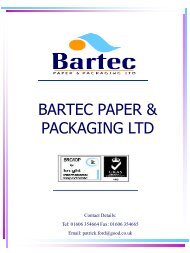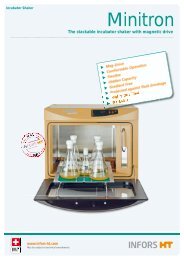fastening & assembly solutions and technology - Approved Business
fastening & assembly solutions and technology - Approved Business
fastening & assembly solutions and technology - Approved Business
Create successful ePaper yourself
Turn your PDF publications into a flip-book with our unique Google optimized e-Paper software.
HOW TO: FASTEN SECURELY<br />
Nuts, bolts <strong>and</strong> screws – in fact, any<br />
threaded fastener - provide the<br />
clamping force in a whole host of industrial<br />
assemblies. This force is generated<br />
by tightening the threaded components<br />
until adequate tension <strong>and</strong> friction is created<br />
within the fastener in order to check,<br />
at least in theory, any movement of the<br />
clamped parts. In reality, however, the<br />
dual circumstances of shock <strong>and</strong> vibration<br />
can reduce this tension <strong>and</strong>, therefore,<br />
permit loosening to take place.<br />
As soon as this initial releasing occurs,<br />
the tension of both the fastener <strong>and</strong> the<br />
clamping load is lost. The result can be<br />
component <strong>and</strong> machinery failure – with<br />
all the resultant problems of down time,<br />
warranty claims, the expense of new<br />
parts <strong>and</strong> loss of confidence.<br />
These engineering adhesives, commonly<br />
known as threadlockers, are generally<br />
anaerobic products that can be<br />
used on any threaded surface. Applying<br />
the adhesive <strong>and</strong> bringing together the<br />
two threaded parts of the fastener forces<br />
out air from the joint <strong>and</strong> thus fill all the<br />
inner spaces between the threads. A<br />
chemical reaction then takes place which<br />
causes the liquid adhesive to harden to<br />
form a solid thermoplastic of a known<br />
strength.<br />
By employing different grades of<br />
adhesive, the strength of the bond can be<br />
varied to provide the essential break<br />
loose torque. However the locking action<br />
of the adhesive does not depend on the<br />
force, a relatively low strength threadlocker<br />
will still produce exceptional<br />
resistance to vibration. And, to carry out<br />
maintenance, the parts can be readily separated<br />
using normal h<strong>and</strong> tools.<br />
Independent assessment<br />
But it is not necessary to take an adhesive<br />
manufacturer’s word for the reliability of<br />
engineering adhesives. In a spectacular<br />
test, a threadlocker was tested on a<br />
Junkers machine used by both the<br />
aerospace <strong>and</strong> automotive industries.<br />
This trial was specifically conceived to<br />
test anaerobic threadlockers against traditional<br />
locking means such as spring<br />
washers, patch bolts, distorted lock nuts<br />
<strong>and</strong> nylon rings. During the test, a fastener<br />
was assembled in the machine <strong>and</strong><br />
tightened down to the required tension.<br />
Once the air hammers were activated a<br />
record was made of the time taken before<br />
the fasteners vibrated loose.<br />
These were intense tests, but the<br />
results showed conclusively that adhesives<br />
provide the most effective protection<br />
against parts working loose under<br />
FAST OCTOBER 2011<br />
Engineering adhesives<br />
ensure fastener security<br />
Engineering adhesives used on fasteners will ensure their efficiency in even the most dem<strong>and</strong>ing of<br />
circumstances. Colin Chapman explains how threaded fasteners can be safe <strong>and</strong> secure even under<br />
great pressure<br />
Colin Chapman is with the marketing<br />
department of Henkel, maker of Loctite<br />
br<strong>and</strong> adhesives<br />
Threadlocking adhesives ensure that bolts are secure –<br />
even under the most dem<strong>and</strong>ing conditions<br />
extreme pressure. In fact, all other methods<br />
failed within less than a minute of the<br />
trial starting.<br />
Of course, discussions – even laboratory<br />
testing - involving threadlockers are<br />
all very fine, but the proof of their effectiveness<br />
is in usage. A few examples will<br />
prove the point.<br />
Take, for instance, the maker of fork<br />
lift trucks who had a requirement to<br />
secure joints between jack cylinders <strong>and</strong><br />
the bearing carrier, <strong>and</strong> to connect the<br />
cylinder to the end plug. Prior to trying<br />
adhesives, welding had been considered<br />
the only way of achieving the needed<br />
assurance. However, not only was this<br />
process time consuming - but also there<br />
was an on-going risk of damage to the<br />
cylinder.<br />
By switching to an adhesive not only<br />
was damage prevented, but also a more<br />
27











